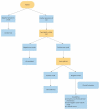Fecal Microbiota Transplantation in Recurrent Clostridium Difficile Infection: Is it Superior to Other Conventional Methods?
- PMID: 32923252
- PMCID: PMC7482981
- DOI: 10.7759/cureus.9653
Fecal Microbiota Transplantation in Recurrent Clostridium Difficile Infection: Is it Superior to Other Conventional Methods?
Abstract
Clostridium difficile (C. difficile) is a gram-positive species of spore-forming bacteria. C. difficile infection (CDI) is one of the most common hospital-acquired infections in the United States, mainly caused by the use of recent antibiotics that leads to intestinal dysbiosis. Recurrent C. difficile infection (rCDI) often occurs after the successful treatment of CDI. Approximately, 30% of patients experience a clinical recurrence of prior symptoms within eight weeks of antibiotic cessation. This present literature review covers the current pathophysiology of CDI, risk factors for infection, diagnostic methods, several treatment modalities, and the potential use of fecal microbial transplant (FMT) for patients with multiple recurrent CDIs. Recent studies have focused on FMT, with an efficacy rate of nearly 90% in multiple recurrent CDI settings. Despite its efficacy, it is not commonly used as first-line treatment. More studies are needed to establish this therapy as the first option in patients with rCDI.
Keywords: clostridium difficile infection; clostridium difficile infection treatment; fecal microbiota transplantation in clostridium difficile infection.
Copyright © 2020, Lin et al.
Conflict of interest statement
The authors have declared that no competing interests exist.
Figures
Similar articles
-
Fecal microbiota transplantation for recurrent Clostridium difficile infection in patients with solid organ transplants: an institutional experience and review of the literature.Transpl Infect Dis. 2018 Dec;20(6):e12967. doi: 10.1111/tid.12967. Epub 2018 Jul 31. Transpl Infect Dis. 2018. PMID: 30011107 Review.
-
Treatment approaches including fecal microbiota transplantation for recurrent Clostridium difficile infection (RCDI) among infectious disease physicians.Anaerobe. 2013 Dec;24:20-4. doi: 10.1016/j.anaerobe.2013.08.007. Epub 2013 Sep 4. Anaerobe. 2013. PMID: 24012687
-
Recurrent Clostridium difficile Infection: Risk Factors, Treatment, and Prevention.Gut Liver. 2019 Jan 15;13(1):16-24. doi: 10.5009/gnl18071. Gut Liver. 2019. PMID: 30400734 Free PMC article. Review.
-
Clostridium difficile Infection and Fecal Microbiota Transplant.AACN Adv Crit Care. 2016 Jul;27(3):324-337. doi: 10.4037/aacnacc2016703. AACN Adv Crit Care. 2016. PMID: 27959316 Free PMC article. Review.
-
Risk of Clostridium difficile Infection with Systemic Antimicrobial Therapy Following Successful Fecal Microbiota Transplant: Should We Recommend Anti-Clostridium difficile Antibiotic Prophylaxis?Dig Dis Sci. 2019 Jun;64(6):1668-1671. doi: 10.1007/s10620-018-5450-4. Epub 2019 Jan 10. Dig Dis Sci. 2019. PMID: 30632052
Cited by
-
Gut Microbiota-Derived PGF2α Fights against Radiation-Induced Lung Toxicity through the MAPK/NF-κB Pathway.Antioxidants (Basel). 2021 Dec 28;11(1):65. doi: 10.3390/antiox11010065. Antioxidants (Basel). 2021. PMID: 35052569 Free PMC article.
References
-
- Clinical practice guidelines for Clostridium difficile infection in adults. Cohen S, Gerding D, Johnson S, Kelly C. Infect Control Hosp Epidemiol. 2010;31:431–455. - PubMed
-
- European society of clinical microbiology and infectious diseases: update of the treatment guidance document for Clostridium difficile infection. Debast SB, Bauer MP, Kuijper EJ. Clin Microbiol Infect. 2014;20:1–26. - PubMed
Publication types
LinkOut - more resources
Full Text Sources

